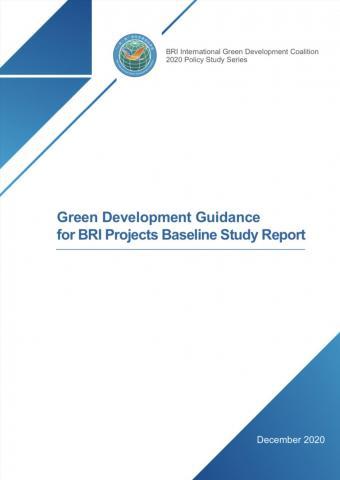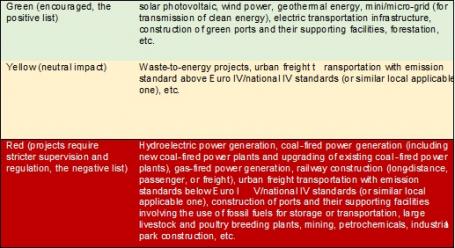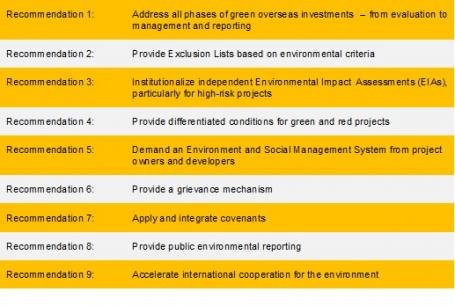Establishing the Positive and Negative Lists for Greener Chinese Belt and Road Projects Overseas

BRI International Green Development Coalition (BRIGC) and the World resources Institute (WRI) launched the Green Development Guidance for BRI Projects Baseline Study (hereafter the “Report”) on December 1, 2020 at the BRIGC 2020 Policy Studies Release event. The Report proposes a three category classification method for BRI projects, based on their climate, ecological and local environmental impacts: the Green encouraged projects, the Yellow neutral projects, and the Red projects requiring stricter supervision and regulation. The research team also developed positive and negative project lists with recommended regulatory and management measures. The report further outlines prioritized areas for formulating the Green Development Guidance for BRI Project (the “Guidance”) that aims to guide BRI investment to shift from brown to green.
Such a Guidance will help stakeholders better align actions to green, low-carbon and sustainable development, and contribute to the high-quality development of BRI that China is committed to. It can be built upon a set of clear and operable guidance from the Report. Among the variety of stakeholders, the Report particularly targeted at:
- Relevant government agencies responsible for formulation and enforcement management policies and standards for overseas investment projects;
- Financial institutions that formulate investment strategy and decisions with considerations of climate and environmental risks; and
- Owners of investment projects responsible for identifying environmental and climate risks and developing and implementing environmental and social safeguard measures with a focus on lifecycle sustainable management practices.
Establishing a project classification system is the core recommendation from the Report in guiding the greening of BRI investment. The classification shall be based on environmental evaluation and mitigation measures that align BRI projects to the Sustainable Development Goals (SDGs), the Paris Agreement, and the Aichi biodiversity targets. The classification benchmarking to these global goals will provide valuable green development reference to BRI countries and attract more global investors.
The proposed classification system looks into three environmental aspects including reducing local pollution, mitigating climate change, and protecting biodiversity.
BRI projects go to one of the three categories after the assessment of environmental impact and contribution:
- Green projects—encouraged projects (positive list): Projects in this “encouraged category” have no significant negative impacts on any of these three environmental aspects above, and positive contribution to at least one environmental aspect, particularly if they support international environmental agreements and conventions.
- Yellow projects—projects with moderate impacts: Projects in this category “Do No Significant Harm” (DNSH) to any environmental aspect, and any residual environmental harm can be mitigated by the project itself through affordable and effective measures within reasonable boundaries.
- Red projects—projects requiring stricter supervision and regulation (negative list): Projects at risk of causing “significant and irreversible” environmental damage or major negative environmental impacts in one or more aspect of climate change mitigation, pollution prevention, and biodiversity protection.
Preliminary positive and negative lists are developed in the Report for selected sectors including energy, transport, manufacturing, mining, and agriculture and land-use.
Extract of projects in positive and negative lists

The Report accentuates regulatory approaches and the whole lifecycle environmental management. For one, this is reflected in the proposition of a two-tier evaluation process in classification. Following the review of environmental impacts and contribution, projects in the red category shall undergo an assessment of management and mitigation measures. Projects can get re-labeled as red/green or red/yellow, only if the significant negative impacts can be abated as the result of applying affordable and effective management and mitigation measures, and in some cases if the projects are even contributing positively to environmental goals during lifecycle.
The Report also proposes regulatory and management measures based on project classification through whole lifecycle environmental management. Particularly,
- Regulatory authorities shall strengthen their policies to support investment to green projects. For example, to explore the provision of incentives for green light projects such as dedicated guarantee and credit enhancement mechanism for green projects.
- In green credit performance evaluation, financial institutions shall report on overseas activities to be comprehensively evaluated on their green performance.
- The investors and regulators engaged in BRI investment shall apply differentiated management to projects according to their environmental risks and impacts, including differentiated decision-making, risk evaluation, financing, performance review, and disclosure for projects on positive and negative lists.
9 Recommendations to Enhance Lifecycle Environmental Management of BRI Investment Projects

Wang Ye, one of the leading authors from WRI, introduces that the Report has developed an analytical matrix to identify international and Chinese best practices on shifting investments from brown to green, covering actions from government, financial institutions and NGOs. Adoption of green list, exclusion list, evaluation of environmental outcomes, differentiated management, and information disclosure are some key areas of action, where the classification of projects according to environmental impact serves as the basis. The classification proposed in the Report considers the enabling effect of the project, the alignment to net zero emission target, and availability of effective management and mitigation measure.
The Report has engaged largely the experts, stakeholders and advisors through interviews and consultation meetings. It proposes the following recommendations on prioritized action areas to the next-step Guidance formulation:
- Establish a classification system for BRI projects focusing on their impact on local environmental pollution, climate change, and biodiversity conservation, and further specify the lists of positive and negative projects with technical guidelines and details provided.
- Explore the environmental risk assessment for BRI key industries in line with the environmental requirements of the host country, as well as with Chinese and international best practices. Guidance and provision of EIA criteria, requirements and tools for key BRI industries to conduct EIA are needed, as well as capacity building to relevant stakeholders
- Establish the mechanism for rigorous supervision and environment and social management system (ESMS) during the whole lifecycle of the project, supported by measurable environmental governance measures. Guide and provide capacity building to project investors and implementers to pursue greener overseas investment with improved ESMS policy, evaluation, management and reporting. Encourage investors to reduce potential environmental risks informed by the project classification and through a grievance redress mechanism that enables responding to environmental complaints in a timely and transparent manner.
- Establish a sound incentive and punishment mechanism to guide financial institutions for differentiated management of projects, according to environmental risks and impacts. Encourage financial institutions, investors, project implementors, and government agencies to shift investment to green by classifying BRI project based on their environmental impact, and applying the appropriate lifecycle management featuring differentiated decision-making, risk evaluation, financing, performance review, and disclosure for projects on positive and negative lists.
- Support piloting and promote application of the Green Development Guidance for BRI Projects. Considering the contexts of BRI countries, a classification system and project lists adapted to local resources, environment, and socioeconomic conditions should be developed as a reference for the host governments. Local demonstrations should be promoted to encourage and facilitate its extension into more Belt and Road countries.
Background of the Project
In April 2019, Chinese and international partners officially launched the BRI International Green Development Coalition (BRIGC) at the Second Belt and Road Forums for International Cooperation. BRIGC aims to establish a policy dialogue and communication platform, an environmental knowledge and information platform, and a green technology exchange and transfer platform, so as to advance global consensus, understanding, cooperation, and action of a green Belt and Road Initiative (BRI). WRI is the partner in BRIGC and co-leads two Thematic Partnerships in the field of green finance and investment, and green cities.
BRIGC officially launched the Joint Research on Green Development Guidance for BRI Projects (Guidance Project) in December 2019, with the purposes to explore the formulation of guidelines on the classification of BRI projects and forming the positive and negative lists focusing on the environmental, climate and biodiversity impacts of projects. The Guidance project provides green solutions for BRI project and BRI countries, and supports the green decision making for stakeholders.
The Guidance Project will develop the policy framework and practical guidelines for the green development of the BRI projects from multiple perspectives, and a series of targeted research reports will be formed. This report is the Phase I Baseline Study.
